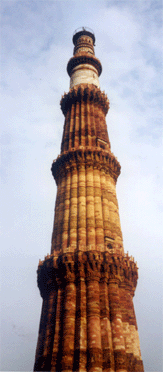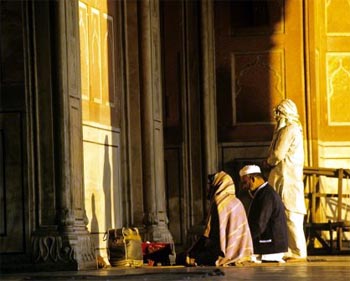Dec 07, 2025
Dec 07, 2025
 Though it had been the subject of marauding Muslim raids since the 8th century A.D., it was not until 1192 A.D. that Delhi got its first Muslim ruler - Qutb-ud-Din Aibak - the founder of the so-called Slave or Mamluk dynasty. A combination of superior tactics and weaponry and the infighting amongst the region's Hindu princedoms combined to make the forces of Islam irresistible, much like in the rest of the civilized world. It is also accepted that raids for land or booty were later 'translated' into more acceptable crusades for conversion of the infidel by many contemporary writers - and this could be one reason for the new Muslim rulers to feverishly start building activity as another sign of their missionary zeal.
Though it had been the subject of marauding Muslim raids since the 8th century A.D., it was not until 1192 A.D. that Delhi got its first Muslim ruler - Qutb-ud-Din Aibak - the founder of the so-called Slave or Mamluk dynasty. A combination of superior tactics and weaponry and the infighting amongst the region's Hindu princedoms combined to make the forces of Islam irresistible, much like in the rest of the civilized world. It is also accepted that raids for land or booty were later 'translated' into more acceptable crusades for conversion of the infidel by many contemporary writers - and this could be one reason for the new Muslim rulers to feverishly start building activity as another sign of their missionary zeal.
Thus the Muslim dominance in India starts with the Slave Dynasty (1192 A.D.) and goes on till the British achieved pre-eminence in the early 19th century.
In succession, this translates into the following dynasties at Delhi: Slave (1192-1246 A.D.), Khilji (1290-1320 A.D.), Tughlaq (1320-1413 A.D.), Sayyid (1414-1444 A.D.), Lodi (1451-1557 A.D.) and finally the great Mughals.
Muslim building types
Throughout, Muslim rule was marked by spectacular monuments, many of which count as among the finest in the world. Islamic building types may be divided into two main categories:
a) religious and
b) secular buildings.
Religious Buildings
To use a quote:
"The fundamental Islamic dogma is the unity of God (Allah) and the finality of the prophethood of Muhammed - His chosen one who lived from c. 570-632. The essence of God is inapprehensible and knowledge of Him depends upon the ninety-nine names which He gives Himself in His revelations. The supreme revelation is the Koran, dictated to Muhammed. As the book of Law, the Koran spells out the conditions for submission (Islam) and the consequent moral obligations of the believer (Muslim), the Five Pillars of Islam: affirmation of the Creed, prayer1, fasting, alms-giving and pilgrimage. 2
 It is the pre-eminence of prayer that dominates much religious architecture in Islam. The Koran lays down a precise ritual wherein the prayer mat is on the axis (qibla) towards Mecca. Thus the principal public place of worship - the mosque or masjid - must provide for the considerable number of mats used as a community, especially at the Friday (juma) noon prayers.
It is the pre-eminence of prayer that dominates much religious architecture in Islam. The Koran lays down a precise ritual wherein the prayer mat is on the axis (qibla) towards Mecca. Thus the principal public place of worship - the mosque or masjid - must provide for the considerable number of mats used as a community, especially at the Friday (juma) noon prayers.
From these constraints a mosque-form begins to evolve - a large rectangular enclosure on one end of which is a wall articulating the qibla by means of a central recession (mihrab). The principal vertical features are minarets or towers at corners (from which the faithful are called to prayer). A lecturn for the Koran and a pulpit (minbar) to the right of the mihrab complete the basic furniture.
The second major religious building type was the tomb, hitherto unknown in India. The tomb as a form made a modest beginning with small canopies over the graves of Sufi saints, and soon led to the erection of increasingly complex structures culminating, in India, in the monumental mausoleums of the Mughal emperors.
Secular structures
Having conquered by war, the Muslims were very conscious of the need for strong fortifications - and these often reflect parallel developments in the West - influence being derived from the Holy Land - the Middle East. Gradually these defensive forts developed into cities in which a large number of other structures were built - wells, palaces, stables and halls of audience.
A fusion of cultures - Indo-Islamic Architecture
"Nothing could illustrate more graphically the religious and racial diversity, or emphasize more decisively the principles underlying the consciousness of each community, than the contrast between their respective places of worship, as represented by the mosque on the one hand, and the temple on the other…Compared with the clarity of the mosque, the temple is an abode of mystery; the courts of the former are open to light and air, with many doorways, inviting publicity, the latter encloses 'a phantasma of massive darkness', having somber passages leading to dim cells, jealously guarded and remote ... architecturally the mosque is wholly visible and intelligible, while the temple is not infrequently introspective, complex and indeterminate." 3
"On the one hand was the rhythmic mind of the Hindu, on the other the formal mind of the Musulman." 4
These quotes from a venerable early architectural historian serve to highlight the utter difference between Muslim and Hindu building types. There were other variations apart from the merely formal: the presence of carving in Hindu temples which was forbidden in Islam, decorative lettering on mosques and tombs which was unknown in Hindu art and architecture, the Hindu propensity for a single stone and the Muslim penchant for inlay work.
However in spite of this wide gulf, over the years a certain symbiosis did come into being between Muslim designers and master-builders and the Hindu craftsmen who carried out their bidding. Both benefited from the other's knowledge and what slowly evolved was a distinct new style of architecture - Persian in inspiration but very Indian in execution. Long referred to as Saracenic, it is now more properly termed Indo-Islamic.
We will trace the development of Indo-Islamic architecture from its crude beginnings in the early 12th century to its heyday. It is not just a story about architecture, it is a whole new civilization developing in the fertile plains of India which left an indelible mark on its future.
1 My highlights
2 Tadgell, Christopher The History of Architecture in India Penguin Books (India) Ltd., New Delhi, 1990.
3 Brown, Percy Indian Architecture (Islamic Period) D.B. Taraporevala Sons and Co. Pvt. Ltd. Bombay, 1975.
4 ibid.
02-Oct-2001
More by : Ashish Nangia